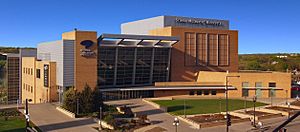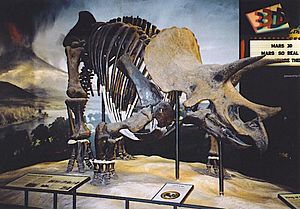Science Museum of Minnesota facts for kids
 |
|
| Lua error in Module:Location_map at line 420: attempt to index field 'wikibase' (a nil value). | |
| Established | 1907 |
|---|---|
| Location | 120 W. Kellogg Boulevard, Saint Paul, Minnesota, United States |
| Type | Science museum |
The Science Museum of Minnesota is a super cool place in Saint Paul, Minnesota. It's all about technology, natural history, physical science, and mathematics. This museum first opened its doors in 1907. It's a nonprofit organization, which means it uses its money to help people learn. Many dedicated volunteers also help the museum run smoothly.
Contents
Exploring the Museum's History
How the Museum Started
A group of business leaders, led by Charles W. Ames, created the museum in 1906. They wanted to help people in St. Paul learn more about science. It was first called the St. Paul Institute of Science and Letters. The museum was originally located at the St. Paul Auditorium.
Moving to New Homes
In 1927, the museum moved to the Merriam Mansion on Capitol Hill. This new spot gave them more room for their exhibits. As the museum grew, it moved again in 1964 to the St. Paul-Ramsey Arts and Sciences Center. By 1978, it expanded even more, adding an IMAX Dome cinema.
Building a New Home by the River
In the early 1990s, plans began for a brand-new building. This new museum would be right next to the Mississippi River. With help from public funding, construction started on May 1, 1997. The amazing new museum opened on December 11, 1999. During the move, 1.75 million items were carefully transported!
Exciting Exhibits and Films Over the Years
Since opening its new building, the museum has hosted many popular exhibits. These include "Tutankhamun: The Golden King and the Great Pharaohs" and "Star Wars: Where Science Meets Imagination". They also showed "Real Pirates: The Untold Story of the Whydah" and "The Science Behind Pixar". The museum also creates its own films for giant screens, like "Jane Goodall’s Wild Chimpanzees" and "National Parks Adventure". They also design and build exhibits for other museums around the world.
Awesome Museum Exhibits to See
The museum always has several cool exhibits for you to explore:
- The Dinosaurs & Fossils Gallery shows off real and copied dinosaur skeletons. You can also see many complete and preserved animals. Some highlights include a Triceratops, Diplodocus, and Allosaurus. You can also see a giant "terror bird" and an armored glyptodont. Look for the two huge, sculpted Quetzalcoatluses, which were giant flying reptiles!
- The Human Body Gallery teaches you about your own body. You'll learn about tissues, organs, and systems like blood or digestion. There's even a mummy on display! An area called "Weighing the Evidence" helps you figure out what's true about healthcare. It has items from a collection of old, strange medical devices.
- The Experiment Gallery lets you try out ideas in physics, math, and earth science. It has lots of hands-on displays.
- Sportsology helps you understand how your body moves when you play sports. You can see what it takes to make a basket or score a goal.
- RACE: Are We So Different? is an exhibit that explores the idea of race. It looks at race from a science, culture, and history point of view.
- We Move & We Stay features items and stories about the Dakota and Ojibwe people.
- The Mississippi River Gallery teaches you about the river's environment and animals. It's right next to the real Mississippi River! This gallery also has The Collectors' Corner. Here, kids can bring in natural items they find and trade them for points or other cool artifacts.

Museum Facilities and Research
The Amazing Omnitheater
The museum has a special IMAX theater called the Omnitheater. It can show films on a flat wall screen or on a huge rotating dome. It was the first theater in the northern hemisphere that could do both! The giant weights needed for the rotating system were so big they had to be put in place before the rest of the building was finished. When it opened in 1999, it had the "largest permanently installed electronic cinema projector in the world."
In 2019, the Omnitheater got an upgrade to digital laser technology. It reopened as the world's third-largest digital laser IMAX dome theater. The museum is also a top producer of giant screen films, including:
- Genesis (1978)
- Living Planet (1979)
- The Great Barrier Reef (1981)
- Darwin on the Galapagos (1983)
- Seasons (1987)
- Ring of Fire (1991)
- Tropical Rainforest (1992)
- Search for the Great Sharks (1995)
- The Greatest Places (1998)
- Jane Goodall's Wild Chimpanzees (2002)
- Tornado Alley (2012)
- National Parks Adventure (2016)
- Ancient Caves (2019)
Mississippi River Visitor Center
Inside the museum's lobby, you'll find the National Park Service Visitor Center. It's free to enter! Here, you can learn about the Mississippi National River and Recreation Area. Park Rangers are there to help you explore the river. You can also get information to plan trips to any of the more than 390 national parks.
Center for Research and Collections
The museum has a special team that takes care of over 1.7 million artifacts and specimens. They also do research in biology, paleontology (studying fossils), anthropology (studying humans), water quality, and climate change. They share their knowledge with museum visitors and school groups. The museum's collections are kept in a special storage vault. This vault holds dinosaur fossils, preserved animals, plants, and cultural artifacts. Researchers visit the vault, but it's not usually open to regular museum visitors.
St. Croix Watershed Research Station
The St. Croix Watershed Research Station is located in Marine-on-St. Croix, Minnesota. It's part of the museum's research center. This is where a team of scientists studies water from all over the world.
Kitty Andersen Youth Science Center
The Kitty Andersen Youth Science Center (KAYSC) is a fun learning place for young people.
IDEAL Center
The museum also has the IDEAL (Inclusion, Diversity, Equity, Access and Leadership) Center. This center helps train teachers and leaders from schools and other organizations across the country.
Past Special Exhibitions
The museum often hosts new and exciting special exhibitions. Some past ones include:
- When Crocodiles Ruled (2000)
- Mysteries of Catalhoyuk (2001)
- Playing with Time (2002)
- Vikings: The North Atlantic Saga (2002)
- Robots and Us (2004)
- Strange Matter (2006)
- Body Worlds (2006)
- Animal Grossology (2006)
- Race: Are We So Different? (2007)
- A Day in Pompeii (2007)
- Star Wars: Where Science Meets Imagination (2008)
- CSI: The Experience (2008)
- Water (2009)
- Titanic: The Artifact Exhibition (2009)
- The Dead Sea Scrolls: Words that Changed the World (2010)
- Tutankhamun: The Golden King and the Great Pharaohs (2011)
- Real Pirates: The Untold Story of the Whydah from Slave Ship to Pirate Ship (2012)
- Maya: Hidden Worlds Revealed (2013)
- Ultimate Dinosaurs (2014)
- Space: An Out-of-Gravity Experience (2015)
- Mummies: New Secrets from the Tombs (2016)
- The Science Behind Pixar (2017)
- Towers of Tomorrow with LEGO Bricks (2018)
- Apollo: When We Went to the Moon (2020)
- Skin: Living Armor, Evolving Identity (2021)
Museum Memberships
The Science Museum of Minnesota is part of several important groups. These include the Association of Science-Technology Centers and the American Alliance of Museums. It also helped start NISE Net and takes part in NanoDays.
Learning and Education Programs
The museum has a big STEM learning program. Besides summer camps and field trips, museum educators visit schools. They reach students and teachers in all 87 Minnesota counties every year. They offer field trips, classroom visits, and large group presentations. Topics range from water to engineering. Summer camps help hundreds of students learn about science, technology, nature, and art.


